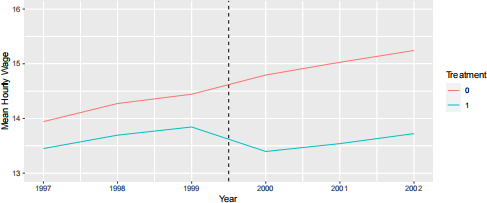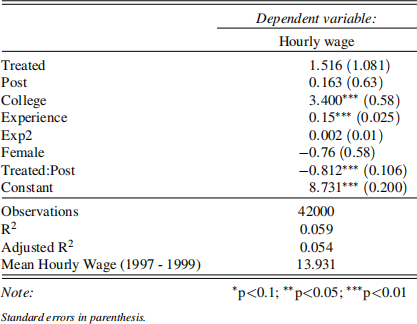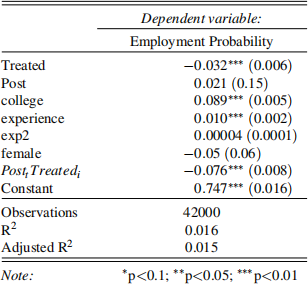Topics in Labor Economics - Problem Set 1
Hello, dear friend, you can consult us at any time if you have any questions, add WeChat: daixieit
Topics in Labor Economics - Problem Set 1
March 2024
This problem set offers you great practice and feedback for the final assessment. Before you start working on the questions, a few general remarks:
• The general rules for academic malpractice apply! If you need a re-fresher, look here https://online.manchester.ac.uk/webapps/blackboard/content/listContentEditable.jsp?content_id=_11454599_1&course_id=_46033_ 1
• Especially: You have to formulate your own answers! This implies three things:
1. You must not copy-paste the answer from other sources (e.g., the lecture notes, other papers,...) but formulate your own answer (this includes you must not write almost an identical sentence and just exchange 1,2 words...).
2. While you can discuss the questions with your classmates you each have to write and submit individual answers!
3. Using software that writes answers for you or external help (someone writ- ing the paper for you) is obviously prohibited.
• Only your results and responses to the questions below will be graded (This means I will not look at your code). While I encourage you to discuss this prob- lem set with your classmates, you all have to submit individual answers (i.e., your submissions will be checked for plagiarism, see point above!)
• You can paste and edit the code from the tutorial in answering your questions. Just be aware, that you need to adjust it to the problem at hand.
• Make sure that your answer is comprehensible. This includes checking spelling, grammar, punctuation, and such. If I cannot understand your response, I cannot give you points on it.
– If you are worried about this, there are resources available to help you with this: https://www.ucae.manchester.ac.uk/
– Of course, you can use programs that check your spelling, e.g. the in-built function in Word.
• Answer your questions with full sentences (essay style). Bullet points are not allowed.
• Allocate your time wisely. If a question gives more points, it means that I expect a more thorough answer.
• Thorough ![]() longer. Try being concise! Most questions do not require a half-a- page answer (check the marks again!)
longer. Try being concise! Most questions do not require a half-a- page answer (check the marks again!)
• You have a (strict)1300 word limit. Copying questions from this sheet to your answer sheet counts towards this limit.
1 Empirical Exercise (28 Marks)
The following results were derived from a panel data set, which contains information about the income of 42,000 individuals from 1997 to 2002 along with some additional demographics.
For this exercise, assume the minimum wage was reformed such that from 2000 onward the minimum wage was reduced from $10 per hour to $8 per hour for people 30 years and younger in 2000 (people born in 1970 or later). Individuals older than 30 in 2000 (i.e., born before 1970) were still subject to the old minimum wage of $10 per hour. A team of researchers is interested in estimating the causal effect of this reform on wages and employment. To this end, they have estimated a Difference-in-Difference
yit = α0 +β1 *Treatedi+β2 *Postt +β3 *Postt *Treatedi+γ′Xit+ εit , ( 1)
where yit is the dependent variable,i.e. the wage in $ of individual i at time t . Treatedi is a dummy variable that takes the value 1 if an individual was 30 or younger in 2000 and zero else. Postt is a dummy variable that takes the value 1 if the year is 2000 to 2002 and zero else. Xit is a vector of individual controls for college degree (Yes = 1), experience, experierience2 and a female dummy, and εit is an iid error term.
Their baseline specification includes all years from 1997 to 2002 and all individuals aged 20 to 40.
1. (2 Marks) In your own words state the parallel trend assumption.
2. (4 Marks) Based on graph 1, would you say that the parallel trend assumption is satisfied? Explain why you have to be careful when basing your argumentation on the graph alone.

Figure 1: Figure corresponding to Q2
3. (2 Marks) Explain why in this specific setting we are not worried about selection into treatment, in the sense of manipulating your treatment assignment.
4. (6 Marks) The estimation results of model (1) are presented in Table1. Interpret the coefficients for Treatedi , Postt, and Postt *Treatedi
Table 1: Baseline Estimation Results for EQ (1)

5. A researcher suggests that the sample should be restricted to 28-33 years old individuals.
(a) (3 marks) Briefly explain the rationale behind this suggestion.
(b) (2 marks) Assume that the coefficient on Postt *Treatedi in this sample is = 0 ( with standard error = 0.0081). Explain what economic channel can account for this precise null result (i.e., the absence of any effect).
6. (3 marks) Define "Spillover Effects" in your own words. Explain why we would be concerned about Spillover Effects in this setting.
7. Table 2 presents the coefficients for the re-estimation of equation (1) using em- ployment as the dependent variable. Employment is defined as whether a person
works positive hours and earns a labor income (= 1) or not (= 0).
(a) (2 Marks) Interpret the coefficient on Postt Treatedi.
(b) (4 Marks) Discuss 2 potential reasons that could explain your result.
Table 2: Results

2024-02-29